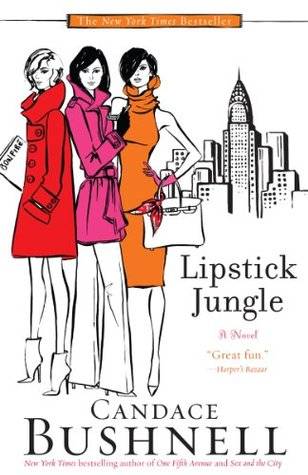

Lipstick Jungle
by Candace Bushnell
In a way, Candace Bushnell's Lipstick Jungle picks up where her career-defining book Sex and the City left off, in the money-soaked, power-hungry, beauty-obsessed jungle that is New York City. This time around, the ladies are a bit older, a lot richer, but not particularly wiser nor more endearing than Bushnell's earlier heroines. Lipstick Jungle weaves the stories of Nico O'Neilly, Wendy Healy, and Victory Ford, numbers 8, 12, and 17 on The New York Post's list of "New York's 50 Most Powerful Women." But this is 21st Century New York, and to get ahead and stay ahead, these women will do anything, including jeopardizing their personal and professional relationships. Take for example Nico, editor-in-chief of Bonfire magazine, who betrays her boss to rise to the top of the entire magazine division at media mega-giant Splatch-Verner. As president of Paradour Pictures, Wendy may be poised to win an Oscar for her 10-year labor-of-love, Ragged Pilgrims, but her marriage is in shambles and her children care more about a $50,000 pony than their mother. And for single, 43-year-old fashion designer Victory, pleasing tough critics may be more important than ever finding the real relationship she's convinced herself she doesn't need. This racy tale of women behaving badly manages to shrewdly flip the tables to show us how gender roles are essentially interchangeable, given the right circumstances. Whether that was Bushnell's intent when crafting this wicked tale is another story. --Gisele Toueg Q: Were Victory, Wendy, and Nico inspired by any real-life women?A: The characters and situations in Lipstick Jungle were inspired by the real-life women I know and admire in New York City. As with Sex and the City, I spent a lot of time thinking about where women were today, and what I noticed was that there was a fascinating group of women in their forties who were leading non-traditional lives. They were highly successful and motivated, they often had children, and usually were the providers for their families, and yet, they didn't fit the old stereotype of the witchy businesswoman. Indeed, so many of these women were the girls next door, the girls who reminded me of my best friends when I was a kid and we used to fantasize about the great things we were going to do in life. Like the women in Sex and the City, the Lipstick Jungle women are charting new lives for themselves, redefining what it means to be a woman when you really are as powerful, or more powerful, than a man. Of course, you probably want specifics, so I will say that there was a moment when it all clicked. Tina Brown used to write a terrific column in the Washington Post, and one of the things she was always mentioning was how there was a group of powerful women who were meeting and lunching at Michael's restaurant. They'd been working for over twenty years, their children were now in their early teens and didn't need them every minute, and now, in their forties or early fifties, they had time to strive for new career goals and to spend more time with their girlfriends. I thought, "Aha--that's the Lipstick Jungle." Q: What kind of research did you do to cover fashion, film, and publishing in one book?A: To research fashion, film and publishing, I did what I always do--I talked to my girlfriends! Of course, it helps that I've worked in magazine publishing and have had my share of experience with Hollywood. I'm also lucky enough to have a couple of girlfriends who are top designers, who offered to help me out with the specific details. I still remember the afternoon when one of my girlfriends and I sat down to talk--she was over eight months pregnant, and I was worried that we were going to have to run to the hospital!
Release Date:
August 7, 2006

